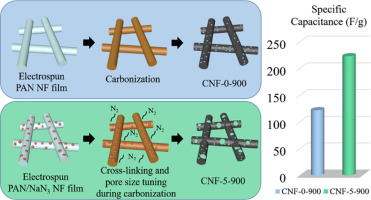当前位置:
X-MOL 学术
›
Mater. Des.
›
论文详情
Our official English website, www.x-mol.net, welcomes your
feedback! (Note: you will need to create a separate account there.)
Crosslinked carbon nanofiber films with hierarchical pores as flexible electrodes for high performance supercapacitors
Materials & Design ( IF 7.6 ) Pub Date : 2018-03-01 , DOI: 10.1016/j.matdes.2017.12.028 Jianping Ding , Hong-ping Zhang , Xiaodong Li , Youhong Tang , Guangcheng Yang
Materials & Design ( IF 7.6 ) Pub Date : 2018-03-01 , DOI: 10.1016/j.matdes.2017.12.028 Jianping Ding , Hong-ping Zhang , Xiaodong Li , Youhong Tang , Guangcheng Yang

|
Abstract Flexible, cross-linked carbon nanofibers (CNFs) film with hierarchical micro-meso-macro-porous structure is prepared by carbonization of the elestrospun polyacrylonitrile (PAN)/NaN3 composite nanofiber mats. The gas liberation of NaN3 during the carbonization is responsible for the tuning of both specific surface area and the pore size distribution. In addition, the exothermal decomposition of NaN3 at the heating stage of carbonization leads to the melting of the PAN/NaN3 composite fibers, resulting in a cross-linked CNF structure. The CNF film with 5 wt% NaN3 carbonized at 900 °C (CNF-5-900) shows a high specific capacitance of 222.92 F g− 1, nearly twice as high as that of the CNF film without NaN3 (CNF-0-900). It also shows an excellent capacitance retention ratio of 81.97% of its initial capacitance from 0.5 A/g to 50 A/g, much superior to the value of 51.02 % for CNF-0-900. Moreover, it has an excellent cycling stability with cycling retention ratio achieves 94.5% after 10,000 charge-discharge cycles. Coupled with its excellent mechanical stability (only 1.6% conductivity loss after bending of CNF-5-900 film at curvature radii (r) = 2.5 × 10− 3 m for 10,000 cycles) and facile fabrication process, the flexible, cross-linked CNF films with hierarchical micro-meso-macro-porous structure is a potential electrode materials and/or backbone to support other active materials for various application, including the flexible energy storage and electrocatalytic.
中文翻译:

具有分级孔的交联碳纳米纤维薄膜作为高性能超级电容器的柔性电极
摘要 通过电纺聚丙烯腈(PAN)/NaN3 复合纳米纤维毡的碳化制备了具有分级微-中-大孔结构的柔性交联碳纳米纤维(CNFs)薄膜。碳化过程中 NaN3 的气体释放负责调节比表面积和孔径分布。此外,NaN3 在碳化加热阶段的放热分解导致 PAN/NaN3 复合纤维熔化,从而形成交联的 CNF 结构。含有 5 wt% NaN3 在 900 °C 碳化的 CNF 薄膜 (CNF-5-900) 显示出 222.92 F g−1 的高比电容,几乎是不含 NaN3 的 CNF 薄膜 (CNF-0-900) 的两倍)。在 0.5 A/g 至 50 A/g 范围内,它还显示出优异的电容保持率,达到其初始电容的 81.97%,远优于 CNF-0-900 的 51.02% 值。此外,它具有优异的循环稳定性,10,000次充放电循环后循环保持率达到94.5%。再加上其优异的机械稳定性(CNF-5-900 薄膜在曲率半径 (r) = 2.5 × 10− 3 m 处弯曲 10,000 次循环后仅 1.6% 的电导率损失)和简便的制造工艺,灵活的交联 CNF具有分级微-中-大孔结构的薄膜是一种潜在的电极材料和/或骨架,可用于支持其他各种应用的活性材料,包括柔性储能和电催化。
更新日期:2018-03-01
中文翻译:

具有分级孔的交联碳纳米纤维薄膜作为高性能超级电容器的柔性电极
摘要 通过电纺聚丙烯腈(PAN)/NaN3 复合纳米纤维毡的碳化制备了具有分级微-中-大孔结构的柔性交联碳纳米纤维(CNFs)薄膜。碳化过程中 NaN3 的气体释放负责调节比表面积和孔径分布。此外,NaN3 在碳化加热阶段的放热分解导致 PAN/NaN3 复合纤维熔化,从而形成交联的 CNF 结构。含有 5 wt% NaN3 在 900 °C 碳化的 CNF 薄膜 (CNF-5-900) 显示出 222.92 F g−1 的高比电容,几乎是不含 NaN3 的 CNF 薄膜 (CNF-0-900) 的两倍)。在 0.5 A/g 至 50 A/g 范围内,它还显示出优异的电容保持率,达到其初始电容的 81.97%,远优于 CNF-0-900 的 51.02% 值。此外,它具有优异的循环稳定性,10,000次充放电循环后循环保持率达到94.5%。再加上其优异的机械稳定性(CNF-5-900 薄膜在曲率半径 (r) = 2.5 × 10− 3 m 处弯曲 10,000 次循环后仅 1.6% 的电导率损失)和简便的制造工艺,灵活的交联 CNF具有分级微-中-大孔结构的薄膜是一种潜在的电极材料和/或骨架,可用于支持其他各种应用的活性材料,包括柔性储能和电催化。











































 京公网安备 11010802027423号
京公网安备 11010802027423号